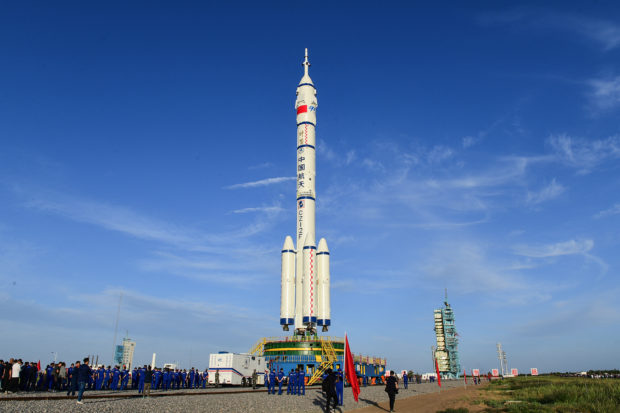
This photo taken on June 9, 2021 shows a Long March-2F carrier rocket, carrying the Shenzhou-12 spacecraft for China’s first manned mission scheduled for June 17 to its new space station, at the Jiuquan Satellite Launch Centre in the country’s northwestern Gansu province. AFP
BEIJING — A Chinese spacecraft will blast off from the Gobi Desert on a Long March rocket in the coming days, ferrying three men to an orbiting space module for a three-month stay, the first time China has sent humans into space for nearly five years.
Shenzhou-12, meaning “Divine Vessel,” will be the third of 11 missions needed to complete China’s space station by 2022. Among them, four will be missions with people on board, potentially propelling up to 12 Chinese astronauts into space – more than the 11 men and women that China has sent since 2003.
The craft will also carry into space the hopes of some in Earth’s most populous nation.
“The motherland is powerful,” one person wrote on Chinese social media, which has lit up with well-wishes for the Shenzhou-12 crew. “The launch is a gift to the 100th anniversary of the founding of the Communist Party.”
Chinese astronauts have had a relatively low international profile. A U.S. law banning NASA from any connection with China means its astronauts have not been to the more than two-decade-old International Space Station, visited by more than 240 men and women of various nationalities.
China, which aims to become a major spacefaring power by 2030, in May became the second country to put a rover on Mars, two years after landing the first spacecraft on the far side of the moon.
It also plans to put astronauts on the moon – the farthest celestial body that humans have traveled to.
This time, men
The Shenzhou-12 crew is to live on the Tianhe, “Harmony of the Heavens,” a cylinder 16.6 meters (55 feet) long and 4.2 meters (14 feet) in diameter.
The planned three-month stay would break the country’s record of 30 days, set by the 2016 mission – China’s last crewed flight – of Chen Dong and Jing Haipeng to a prototype station.
Three men from China’s first and second batches of astronauts will be on this mission, Yang Liwei, director of the China Manned Space Engineering Office and China’s first astronaut, told state tabloid Global Times last month.
China’s space bloggers speculate they will be Nie Haisheng – who at 56 would be China’s oldest astronaut sent into space – Deng Qingming, 55, and Ye Guangfu, 40.
The authorities typically do not announce a mission’s crew until near or after the launch. China Manned Space did not respond to a Reuters fax request for comment.
The oldest human in space was John Glenn, who flew on the space shuttle at age 77 in 1998 – after having been the first American to orbit the earth in 1962, a U.S. senator and a presidential candidate.
While no women are scheduled for the Shenzhou-12 mission, they are expected to participate in every following mission, Yang told Global Times.
Two women, Liu Yang and Wang Yaping, were selected in 2011 among China’s second cohort, after the first batch of 14 men in the mid-1990s. Liu was China’s first woman in space in 2012, while Wang was the youngest, at 33, in 2013.
China began building its space station in April with the launch of Tianhe, the first and largest of its three modules. This year it aims to send a robotic cargo resupply spacecraft and three more astronauts, this time for a six-month stay. (Reporting by Ryan Woo and Liangping Gao; Editing by William Mallard)